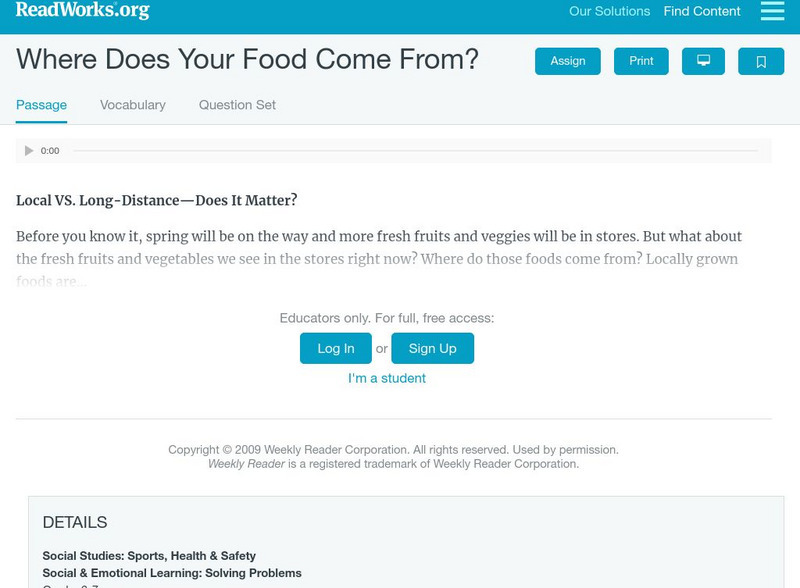Curated OER
Solar S’Mores
Students use the energy of the sun to make s'mores. In this solar energy instructional activity, students gather the listed materials and follow the procedures to find out if they can make s'mores using solar energy.
Curated OER
Mussel Movements
Students consider the impact of invasive species on local environments. In this ecology lesson, watch the video, Arizona Wildlife Views, which focuses on invasive species. Students develop vocabulary, relate to meaningful comprehension...
Curated OER
Gluten and Balloons What Do They Have In Common?
Students examine the purpose of gluten in bread making and what type of flour is needed to make bread. They compare the properties of a balloon to bread dough to explain yeast fermentation. They make bread.
Curated OER
NECESSARY WRAPPERS?
Students bring in a packaged item to unwrap. They weigh the pile of packaging and pile of product and determine which weighs more. They identify the source of raw materials for packaging and discuss ways to reduce packaging and overall...
Curated OER
Feudalism
Students have tournaments in teams after learning information about The Middle Ages. In this Middle Ages lesson plan, students learn that tournaments are mock battles, but that they will have these battles by answering questions in teams...
Curated OER
Life of a Logger
Students are introduced to the work and lives of 19th century lumberjacks through a living history slide show presentation. They compare and contrast life 150 years ago with the present. Students describe the history of logging in...
Curated OER
Cranes, Crosswalks, and Big Gulps
Learners watch a video and answer questions based on wildlife jobs. In this wildlife lesson plan, students learn that biologists don't just play with animals but that there is a lot of study involved.
Curated OER
Environment
Students examine how connected they are to the environment and how organisms are affected by other organisms. They also discover that the environment is affected by human interactions.
Curated OER
Pollination Station
Students investigate why and how bees pollinate flowers and other plants. They define pollination, and read and sing along with the song "Yo, i'm a Flower." Students examine a diagram of a flower, simulate bees pollinating flowers, and...
Curated OER
Discovering Owls
Pupils are introduced to different types of owls and owl pellets. They list several adaptations that benefit the owls. Students identify the various species of owl that live in Wisconsin. Pupils discuss owl pellets and identify the...
Curated OER
Shiloh Chapters 9 and 10
For this comprehension worksheet, students read chapters 9 - 10 of Shiloh and complete multiple choice questions. Students complete 11 questions.
Curated OER
Scales, Scutes, and Skins
Students identify the various adaptations of reptiles and amphibians. After distinguishing between reptiles and amphibians, students discuss the ways in which their adaptations aid in their survival. They participate in a hands on...
Curated OER
Greenwich
In this literacy worksheet, students complete a transcript that is based upon the geographical location of Greenwich. There is also a search for numbers that are found in the text.
Curated OER
Solar S'Mores
Students investigate solar energy. In this solar energy lesson, students compare how heat is absorbed in light-colored objects and dark-colored objects by making S'mores.
Curated OER
Solar S’Mores
Students cook with the power of the sun. For this solar energy lesson, students explore solar cooking as they apply scientific principles to cook s'mores.
Read Works
Read Works: Where Does Your Food Come From?
[Free Registration/Login Required] An informational text about where our food comes from and the pros and cons of buying locally. A question sheet is available to help students build skills in reading comprehension.
OpenSciEd
Open Sci Ed: 7.4 Matter Cycling & Photosynthesis
Where does food come from and where does it go next? This unit helps students figure out that they can trace all food back to plants, including processed and synthetic food. They obtain and communicate information to explain how matter...
TED Talks
Ted: Ted Ed: A Guide to the Energy of the Earth
Energy is neither created nor destroyed - and yet the global demand for it continues to increase. But where does energy come from, and where does it go? This video examines the many ways in which energy cycles through our planet, from...
TED Talks
Ted: Ted Ed: Why Do We Pass Gas?
Flatulence is a daily phenomenon. In fact, most human beings pass gas 10-20 times a day (yes, that includes you). Where does your bodily gas come from? This learning module takes us on a journey into the intestines, shedding light on how...




















